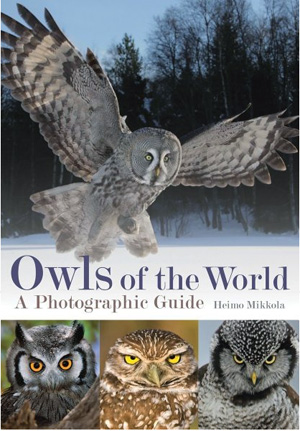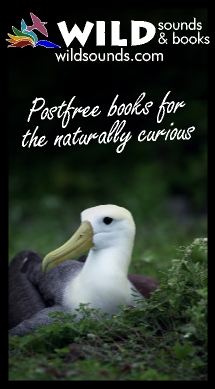Book review: Owls of the World: A Photographic Guide
Author: Mikkola, Heimo

There can be no more charismatic group of birds than the owls. Much-loved by the general public and much-desired by birdwatchers, they are for many the most exciting birds around. Some are familiar and well known to all but some are so rare that they have hardly ever been seen, let alone described or photographed. The appearance of a new photographic guide to the owls of the world is therefore something to be keenly anticipated. When it is written by no lesser authority on owls than Heimo Mikkola, then expectations are high indeed. Mikkola needs little introduction. He has worked with owls for nearly fifty years both in his native Finland and throughout the world but in Britain he is best known for his 1983 Owls of Europe in the Poyser series. So, how does his new book stack up?
Its introductory sections cover such topics as ‘what makes an owl?’, the nature of owls, evolution, biogeography, taxonomy, owls and humans, conservation, extinct owls, ‘owlaholics’ and owl associations. These initial chapters, though relatively short, are clear, well illustrated and informative.
The taxonomy section is particularly interesting, highlighting the current state of taxonomic flux and emphasising that the judgements made in the book over which ‘species’ to include are likely to be neither definitive nor final. A ‘liberal’ taxonomy is generally adopted (in line with König et al., 2008) though a large number of current subspecies are also ‘flagged up’ as potential future ‘splits’. Any taxonomic (and indeed nomenclatural) treatment these days (particularly of such a group as the owls) is bound to provoke debate and invite comparison with other publications/lists. The author for example does not recognise the proposed ‘split’ of Northern Boobook but does ‘split’ American Barn Owl and Lilith Owl. Any such controversy is, however, likely to be confined to the realm of avid world listers and checklist updaters. Most readers will be less concerned with such matters, and most of the taxonomic minefields are sidestepped anyway by the author’s commendable emphasis on subspecies and ‘species in waiting’.
The meat of the book is, of course, the individual species accounts, with 249 species described. Each follows a standard format covering identification, calls, food and hunting, habitat, status and distribution, geographical variation (listing and briefly describing all recognised subspecies) and similar species. Each species has a range map of a good size, largely based on that in König et al. but updated where new information is available. The text is clear and concise though the individual sections are on the short side and often leave the reader wanting more. With some particularly well-studied species, such as Barn Owl, the task of deciding what to leave out must have been daunting whereas for some barely-known species the gaps in our knowledge are all too obvious. I found little to quibble with in the text though the statement that Northern Hawk Owl “winters irregularly south to C & SE Europe (including, rarely, the Shetlands and Orkneys)” might raise some eyebrows!
With a relatively sparse text, the focus of the book falls on the photographs, and this is a splendid collection indeed! It contains over 750 images of almost all the known species, with multiple images for most. Only a tiny handful have never been photographed in the wild and, for one or two, only photographs of museum specimens are available. Nevertheless, the task of sourcing images of nearly 250 species (and many subspecies too) must have been daunting. The result is a credit both to the author and his editorial colleagues and, of course, to the photographers themselves. Indeed the coverage of subspecies is admirable and underpins the author’s expectation that a number of these will at some point be elevated to species status. This is surely the best and most comprehensive collection of owl photographs ever assembled and the standard of images is exceptionally high for almost every species. For such iconic and well-photographed species as Great Grey and Snowy Owls, the images chosen are of the highest quality (as one would expect) whilst the ‘record shot’ images of such little known species as west Africa’s Maned Owl are exciting and tantalising nonetheless. Perhaps most surprising is that so many of the world’s owls have been photographed so well. The average quality of the images is superb.
Hardback: 512 pages
Published: 2012 - Christopher Helm
ISBN: 978-1-4081-3028-5
RRP: £34.99
Special price for RBA users with discount code: SAVE £11.50 - Only £23.49
For details on how to get your exclusive discount code click here
At 512 pages, this is a pleasingly solid and heavy hard-backed book. Its layout is attractive with text, images and captions pleasingly laid out. The photographic reproduction is good and the whole book has a ‘quality feel’ in both its content and visual appearance. It is no ‘field guide’ and will surely never be used in the field or taken on holiday but as a reference book to live at home on the bookshelf and living room table it has much to commend it.
Such a visual treat inevitably prompts thoughts of seeing the birds in the flesh, of course. Few, however, will ever see more than a small proportion of the species in this book. The combination of nocturnal and forest-dwelling habits, restricted distribution and occurrence in remote tropical regions, particularly islands, places many of these owls beyond the reach of most. However, through this book we can at least indulge in some fantasy birding! As a prompter of dreams of some of the world’s most iconic and desirable birds I cannot recommend it highly enough.
Rating
“A feast of high quality images of some of the world’s most desirable birds”.

Andy Stoddart
October 2012






